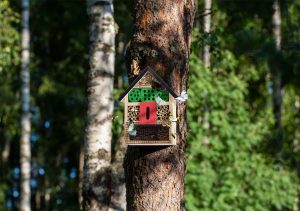How Do Hummingbirds Pollinate?
Insects aren’t the only species that contribute to the process of flower pollination; hummingbirds also play an essential part in pollinating a wide variety of flowers. But how exactly do hummingbirds pollinate/help the flowers?
The large beaks of hummingbirds help them to reach deeply into many flowers in search of nectar. Pollen is collected on the hummingbird’s feathers and bodies when they are in the flower while feeding on nectar. The hummingbird subsequently carries the plant’s pollen to the next flower it visits.

Additionally, hummingbirds can visit dozens of flowers in a single day because they have to eat six to eight times every hour in order to survive. That process also indirectly increases the frequency of pollination by these little birds.
The following adaptations make them the best pollinators:
- The long, narrow bills of hummingbirds enable the birds to reach into flowers with greater depth.
- They also have long, thin tongues that can stretch, allowing them to sip nectar directly from flowers. They are capable of licking ten to fifteen times every second.
- Their feathers are coated in very small hooks that assist in gathering pollen and disseminating it from one flower to another.
- The quick beats of their wings also produce a great deal of turbulence. The turbulence contributes to the pollen’s dissemination from one flower to the next.
- Because of their ability to hover in the air, they are able to visit a greater variety of flowering plants.
- Hummingbirds are known to visit hundreds of different flowering plants every day, and they frequently fly great distances in their hunt for food.
- The ability of a hummingbird to pollinate many kinds of plants over a vast region gives them an essential role in the reproduction of flowers.

Do Hummingbirds Play A Role in the Pollination of Fruit Trees?
Hummingbirds are responsible for transporting pollen from the male part (stamen) to the female part (pistil) in flowers. Even though the stamens and pistil are located within the same flower, a pollinator is still expected to complete the transformation.
Not only do hummingbirds visit flowers to feed on the nectar, but they also help spread the pollen from flower to flower. It paves the way for the plant’s development of fruits or seeds.
For example, a hummingbird will pollinate blueberry blooms when it consumes the nectar & pollen of those flowers when it does its feeding. After that, it will produce fruit, which various other creatures, including humans, will eat.

Providing Assistance to Hummingbirds in Their Pollination Efforts
Those who are interested in birds and know how to attract hummingbirds can contribute to the process of pollination. It will also result in the garden having more lush and ripe flowers. Planting a wide variety of colorful flowers and bird feeders, and creating a secure habitat for hummingbirds by providing them with shade, shelter, food, and water are the most important things you can do to draw them to your backyard.
It is also essential to provide a lot of area between plants for hummingbirds to be able to hover and find their way around. Additionally, the sound and movement of running water are appealing to them. It might be anything as basic as a sprinkler hose, but it could also be a water feature.
Because hummingbirds do not have a very developed sense of smell, they must depend only on the visual of food to guide their search. The red color appeals to hummingbirds. Hummingbirds are more likely to visit your yard if you have red garden furniture and red bird feeders.
In the bird feeder, use sugar water that is unadulterated and pure. Make use of a concoction that has one part of white sugar blended with four parts of water.
Are Hummingbirds the Only Other Birds that Contribute to the Pollination?
Hummingbirds are among the most effective pollinators of flowers, yet they do not perform this function single-handedly. In addition to hummingbirds, the following birds serve best as a pollinator:
- Honeycreepers
- Spiderhunters
- Honeyeaters



Conclusion
Hummingbirds are essential to the reproduction of about 8,000+ tree species in the Americas due to their role as pollinators.
Hummingbirds have undergone significant changes during the course of evolution to better adapt to their natural environment and the foods available to them. As a consequence of this, many hummingbird species are highly sensitive to variations in climate and are dependent on their preferred habitat. So, try to provide the best environment in the form of various juicy flowers and bird feeders in your backyard to attract these birds.
You can also learn more interesting facts about hummingbirds here.Subscribe for more info>>
















Post Comment